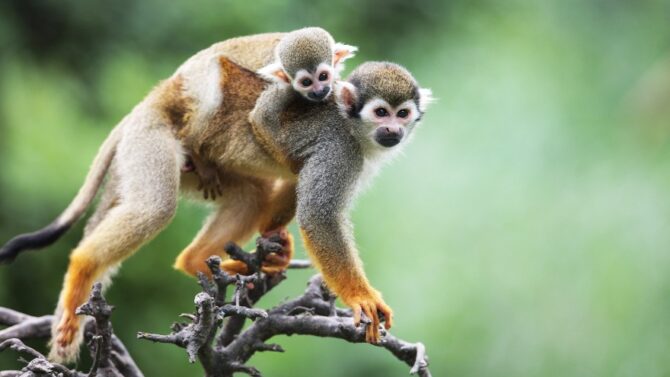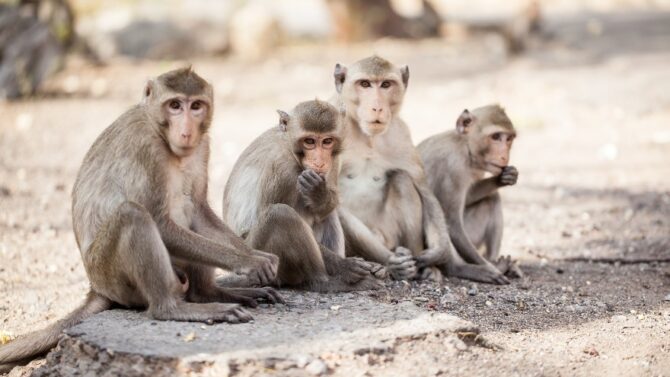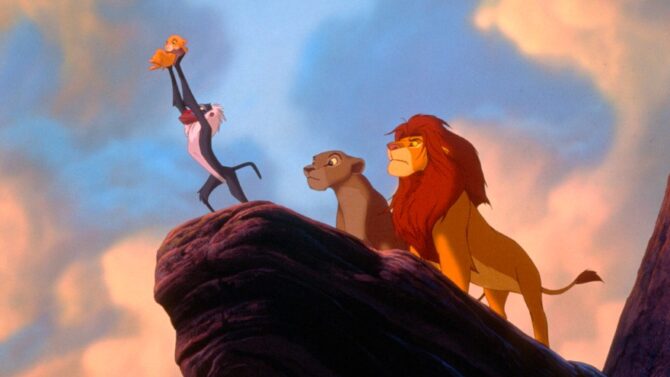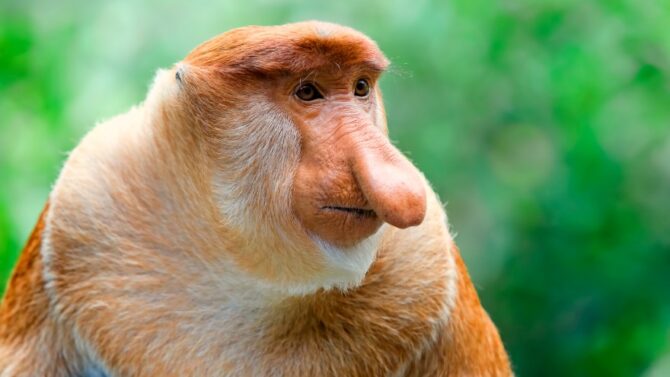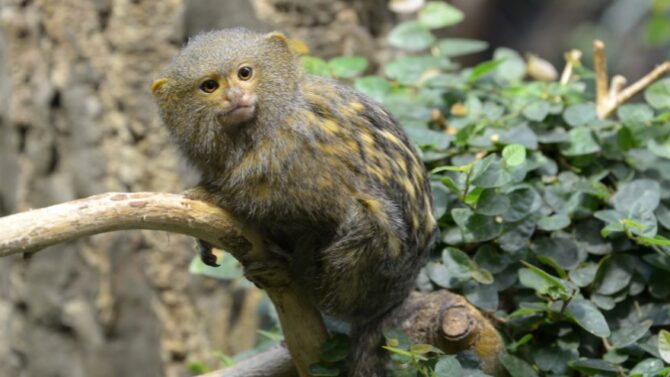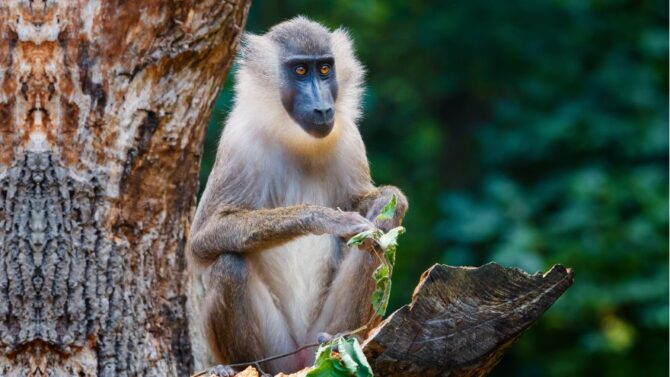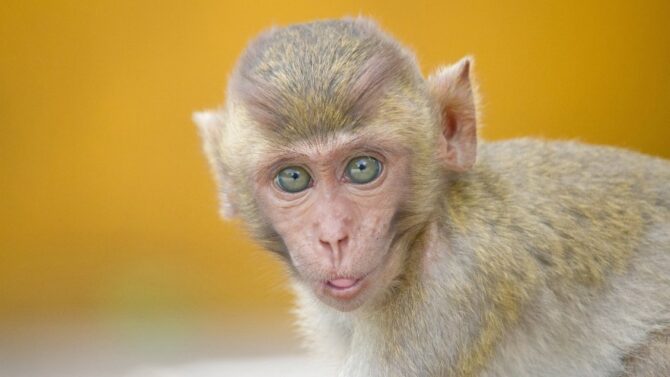The name ‘monkey’ is a common term for mammals that belong to the infraorder Simiformes. Some also call them the simians.
They belong to the same order as humans (both are primates) and share some physical traits in common. These animals also look similar to apes but are classified differently from the latter.
Monkeys and humans have a complex relationship. Some are kept as pets, others as service animals.
Those in the wild get hunted down, and in certain areas, the primates are considered pests. This relationship has made many pick interest in the traits and lifestyle of our animal lookalike.
Scientific Classification
| Kingdom | Animalia |
| Phylum | Chordata |
| Class | Mammalia |
| Order | Primates |
| Suborder | Haplorhini |
| Family | Cebidae |
| Scientific Name | Macaca Fascicularis |
Characteristics
| Height | 19 to 70 cm |
| Weight | 0.22 to 60 pounds |
| Venom/Poison | No |
| Skin Type | Hair |
| Habitat | Tropical forests, grasslands, mountainous plains |
| Range | Africa, Asia, America, Oceania |
| Diet | Omnivore |
| Life span | 10 to 30 years |
| Gestation Period | 152 to 199 days |
| Conservation status | Not Extinct |
5 Interesting Facts About Monkeys
1. The species are at risk
There are over 250 species, but sadly only a few are considered safe. The population decline is concerning, and some species are even facing extinction.
Other primates like gorillas, apes, and lemurs are also facing the same problem. 1
Human activities are at the roots of this. Pollution and the clearing of tropical forests leave monkeys and other primates with no habitat to thrive in.
Consequently, they dwindle in number. They are also hunted and captured for meat and trading.
2. They show affection to themselves
Have you ever seen a monkey grooming the hair of another? This gesture isn’t simply to pick off dirt and debris. It is also an act of affection and even love.
These animals are intelligent and have the ability to feel complex emotions, which include affection. Grooming also helps them feel more comfortable and ultimately strengthens bonds.
Other ways they show affection is by hugging and playing together. This bonding is crucial for survival, especially during fights.
An individual’s team will be made up of friends, which is why they need to bond.
3. There is a pocket-sized and largest species
The size amongst all 250+ species varies, and on the spectrum we have the smallest and the biggest. The smallest is the pygmy marmoset, whose size reflects the name.
It weighs around 0.22 pounds with a height of about 5 inches. The pygmy marmoset can fit into your palms. But do not consider this species for your household. It is not a good pet.
The largest species is the mandrill. Remember the slightly strange Rafiki in The Lion King? That is a good example of a mandrill.
Its weight falls between 25 and 55 pounds on average. Some individuals weigh more than this, going up to 119 pounds! Mandrills have colorful faces and behinds, their unique trait.
4. Owning a pet monkey is illegal in some states
Due to their declining population, this primate is under protection in certain areas. If you live in these states, it is illegal to own a monkey.
These states are New York, California, Colorado, New Jersey, New Mexico, Pennsylvania, Wyoming, Utah, Vermont, Maryland, Maine, Massachusetts, Georgia, Rhode Island, New Hampshire, Kentucky, Louisiana, Minnesota, and Connecticut.
There is no federation rule on owning monkeys as pets, so it is all down to the states to put up their regulations.
Only the 19 mentioned above have outright bans. Some states allow you to own a monkey without any restriction, others have some guidelines.
5. Other primates aren’t monkeys
People erroneously call all other primates monkeys. However, the classifications and traits differ. Other primates are classified as apes and promisians.
Apes comprise of gorillas, chimpanzees and orangutans while promisians regroups lemurs, lorises and tarsiers.
The biggest difference between monkeys and other primates is the absence of tails. The former is characterized by tails, which apes, and lemurs don’t have. Apes are also bigger and more intelligent.
General Description
Monkeys bear a lot of similarities with other primates, and it isn’t a surprise they are often mixed up.
They are relatives because of their classification under the same order, but the monkey has its peculiarities, one of which is the presence of a tail.
For species like the howler and the woolly spider, this organ is prehensile and helps them hang on to trees.
There are over 250 species still in existence today. The common ones include:
- The pygmy marmoset
- The howler monkey
- The mandrill
- The macaques
These species differ from each other in significant ways. The howler is so named because of the sound it makes, the pygmy is the size of a palm and the mandrill has a colorful face. There’s a lot of variety in size, colors, and behaviors.
There are two types of monkeys based on appearance: the old world and the new world. Old world individuals are also called simiiformes catarrhini, while the New World guys are termed simiiformes platyrrhini.
The catarrhini are characterized by a pointed nose and tails that are not prehensile. The platyrrhini, on the other hand, have flat noses and prehensile tails.
The baboon is an example of the first category while the spider monkey represents the second.
Distribution and Habitat
Due to the number of species, this primate is widespread. You can find it in Africa, Asia, and the Americas. The catarrhini belongs to both Africa and Asia while the platyrrhini abounds in Central and South America.
There is only one species in Europe and none in Antarctica as they can’t survive a very cold environment.
Monkeys usually thrive in tropical habitats which the continents mentioned above have in good numbers. Preferred habitats include forests, grasslands, and mountainous plains.
They aren’t limited to tropical areas, though. Baboons stay in dry areas, the golden-headed lion tamarin dwells in a rainy environment, and the Japanese macaque stays in northern parts of Japan where snow sometimes lands on.
Diet
Contrary to what you see on television, monkeys aren’t limited to eating bananas, nor are they only frugivores.
The bananas they eat in the wild are also a different variety from the ones we buy in the supermarket. This is why you shouldn’t feed a monkey banana at the zoo.
These animals are omnivores, eating more than fruits. They feed on both meat and plants, which is a stretch from what we see on television.
Their meat is gotten from insects and grubs. Plants include fruits, nuts, and seeds. Larger individuals can hunt down reptiles like lizards, and some raid bird nests for eggs.
Their dietary choice is influenced by the environment and time. Sometimes they survive on more fruits, other times they go for insects and grubs.
Reproduction and Mating Process
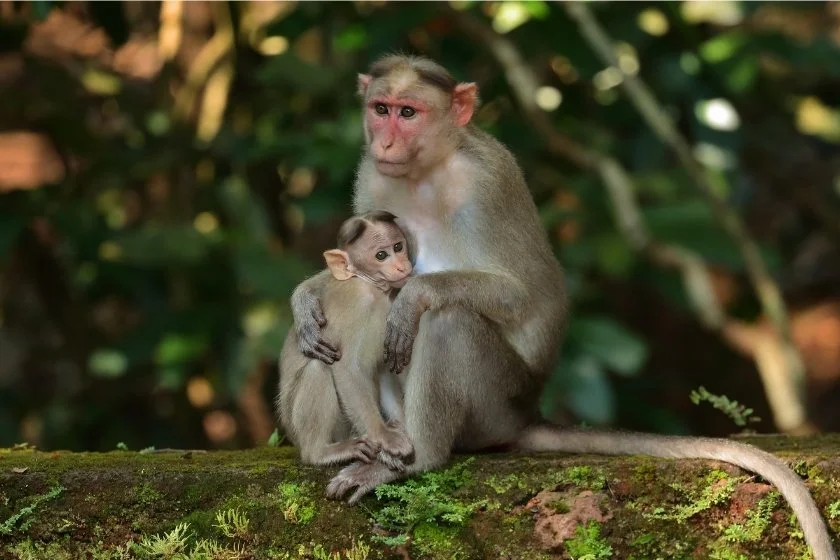
Reproduction can either be selective or natural, depending on where the monkeys are. Those in captivity are usually bred selectively, while those in the wild use natural mating methods.
Selective breeding involves purposely mating a particular male with a female to get offspring. It could also involve artificial insemination.
In the wild, they reproduce without any human intervention. Their process can be paralleled with that of humans, albeit with differences.
Females give birth live to only one or two babies, they have a monthly circle during which they are more likely to get pregnant, and it takes about a year for a female to have a child.
The mating process can be influenced by food, which is one way they differ from humans.
Monkeys can be either monogamous or polygamous. Some form a male-female couple, others can get multiple partners. Many species form family groups that consist of an alpha male and many alpha females.
The baby is called an infant, and at a young age, it relies on its mother for survival. This lasts for the first few months until the infant becomes independent.
For some species, the infant literally clings to the mother till it gains independence.
Predators and Threats
Monkeys face a lot of threats from predators in their habitat. The lion is a popular example, especially in Africa. These big cats don’t hesitate to chase and grab a monkey when the opportunity arises.
Besides lions, some other terrestrial animals that are predators of this primate include snakes, alligators, and cheetahs. Birds of prey like eagles also hunt down monkeys.
We also have threats that stem from human activities, hunting being a prime one. These animals fall, victim to hunters, multiple times, one reason for their decline.
Humans also tamper with their habitats through deforestation, leaving them with fewer trees to be on. Some also get captured and sold as pets.
Behavior
Monkeys behave like intelligent mammals, more than many others. Like humans, they form friendships and enmities, support their close ones, and show affection.
They even show depression when they lose something, like a leader being deposed by someone else.
They are also known to keep grudges and will remember who wronged them in the past.
Generally, most species don’t like moving on the ground. They move from one area to the other by swinging through trees. This process is known as brachiation.
Male vs Female
The differences between sexes depend on the species. For some (like the mandrill), the difference is very noticeable. Not all of them have an obvious gender distinction.
That said, males are generally larger than females. When you meet a group of monkeys, the biggest one is usually a male.
They also tend to get into more fights, especially when they meet a rival or are contending for an alpha position.
Females are usually less aggressive. You can also easily detect a female if she’s carrying an infant.
Frequently Asked Questions
Are monkeys good pets?
While some people do own these animals as pets, it is not such a good idea. Monkeys require a full lifetime commitment that will tire out the average pet parent. Owning one is akin to having a child that never grows. It is also illegal in some states due to other risks incurred. Best to leave them in the wild.聽
Is a monkey friendly?
Regardless of what you see in movies, these creatures are more aggressive than friendly. Some individuals are gentle, but even they can flip and get aggressive too. They are unpredictable and you shouldn’t get too close to a wild one.聽
Are gorillas monkeys?
Gorillas are monkeys are relatives as they are both primates, but they are not the same. The gorilla is classified as an ape and not a monkey.聽
Final Thoughts
With features and behaviors that are quite close to that of a human, it shouldn’t be surprising for anyone to know that we belong to the same order.
These animals are intelligent, extremely curious, and great survivors in their environment.
Many people fancy having one as a pet, but it is better to invest that money in a domestic dog or cat.
Latest Monkeys Articles
References & Notes
- Rice D. Over half of world鈥檚 apes and monkeys in danger of extinction. USA Today.

